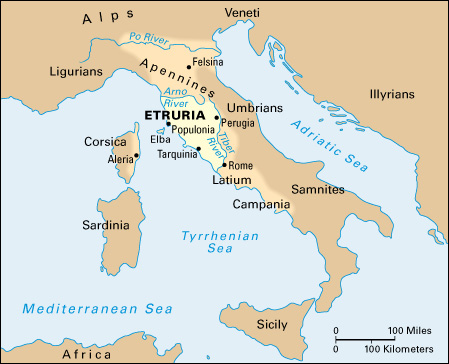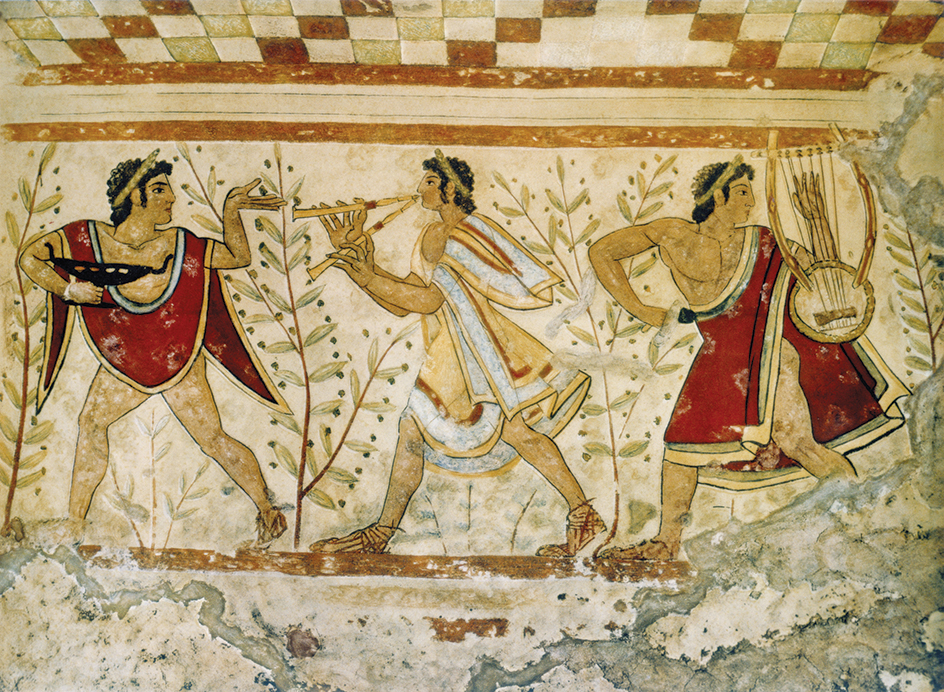Etruscans, << ih TRUHS kuhnz, >> were an ancient Italian people who lived in Etruria (present-day Tuscany, Umbria, and Latium). Etruria extended from the Arno River in the north to the Tiber River in the south, and from the Apennine Mountains in the east to the Tyrrhenian Sea in the west. Archaeologists have shown that a continuous settlement existed in Etruria from prehistoric times. The Etruscans also spread north to the Po Valley and south to Campania. Evidence indicates that the early Etruscans maintained close commercial relationships with other peoples throughout the Mediterranean, beginning in the 700’s B.C. Intense trading with the ancient Greeks and Phoenicians in the 500’s B.C. influenced Etruscan culture and technology.

The Etruscans ruled Rome for more than 100 years, from 616 to 509 B.C. Etruria then suffered an economic and social crisis that lasted until about 400 B.C. In 396 B.C., Rome conquered the Etruscan city of Veii. But Rome did not take complete control of Etruria until the mid-200’s B.C.
Government and economy.
The political unit of the Etruscans was the city. A lucumo (king) ruled each city. Officials called magistrates handled the daily business of cities. Magistrates belonged to a wealthy class and often promoted their own interests at the expense of a large body of poorer citizens.
Twelve of the major cities of Etruria formed a loose organization called the League of Twelve Cities. One of the most important cities was Felsina (present-day Bologna), in the Po Valley. Religion, rather than politics, probably held the league together. Relations between the cities were not always peaceful, and wars sometimes broke out.
The wealth and power of Etruria came largely from copper and iron mining and metalworking, and from the Etruscans’ control of trade in the western Mediterranean Sea. Agriculture, fishing, hunting, and logging also provided income.
Language and culture.
Today, about 13,000 written specimens remain of the Etruscan language, which is written in a script much like ancient Greek. Although modern scholars can interpret individual words and phrases, they cannot fully understand the language.
Etruscan art is characterized by a simple and lively style. The most spectacular examples of Etruscan art are the wallpaintings in Etruscan tombs. The Etruscans were also skilled in making bronze and terra cotta (molded and baked clay) sculpture.

Individuals called haruspices oversaw Etruscan religion. They primarily observed the natural world for signs from the gods and made predictions about the future. The Etruscans believed in life after death. They put clothing, food, furniture, jewelry, and pottery inside tombs to ease the dead’s passage to the afterlife. Duels to the death, which provided entertainment at festivals, served as human sacrifices to the gods of the underworld.
Influence on Rome.
During the period of Etruscan rule, Rome prospered and became powerful. Some of Rome’s political symbols were probably inherited from the Etruscans. The Romans also adopted elements of Etruscan theater and religion. During the period of the Roman Republic (509-27 B.C.), the Roman Senate sometimes consulted the Etruscan haruspices. The Etruscan nobility held considerable influence in Rome until the time of Julius Caesar, who died in 44 B.C.
